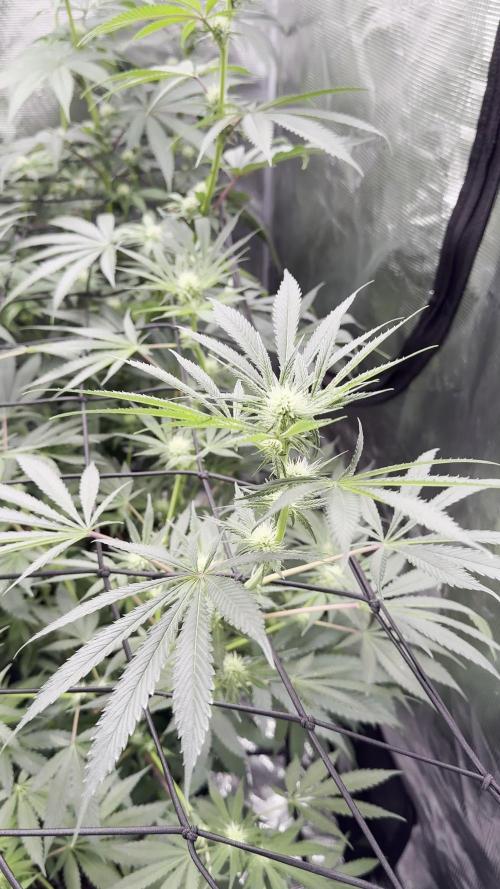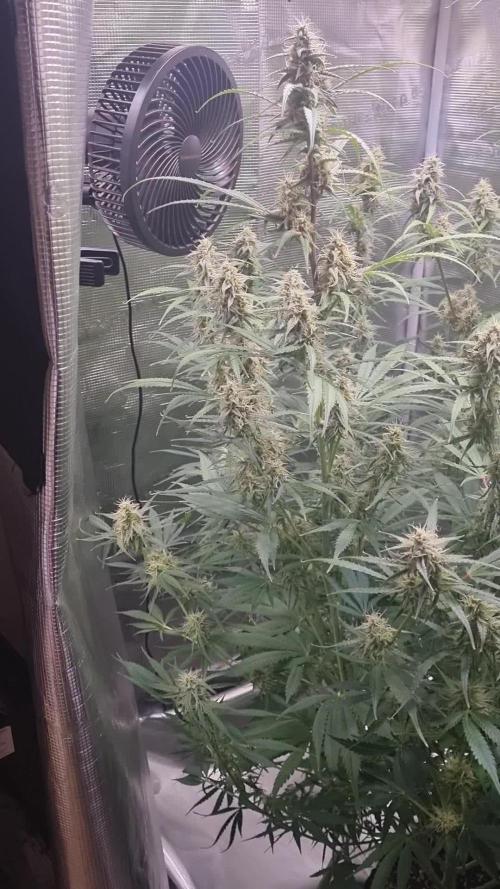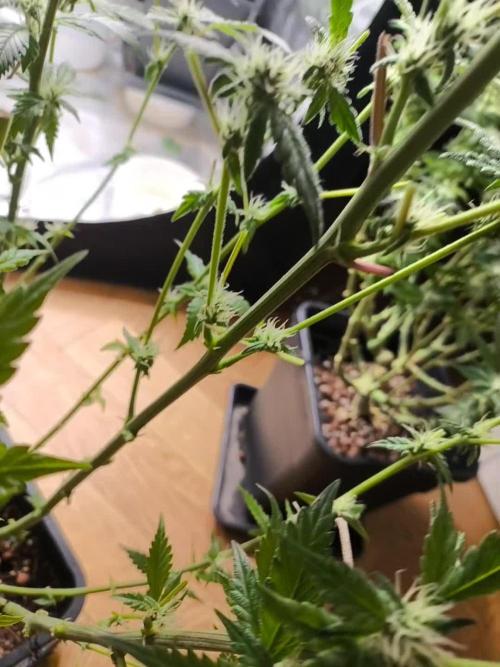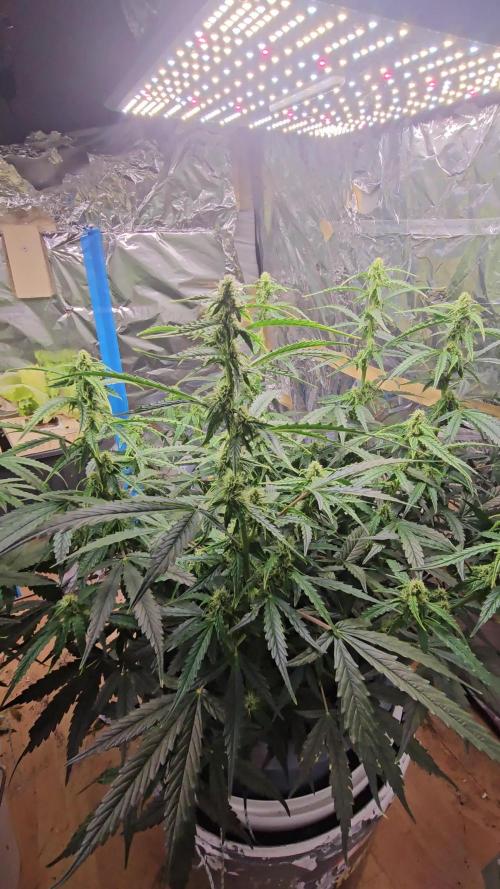The Grow Awards 2026 🏆 



































Likes
Comments
Share


@eldruida_lamota
Follow
Vamos familia sexta semana floración de estás Pink Runtz de RoyalQueenSeeds.
Que ganas tengo de ver el progreso de esta variedad, las plantas están marcando una deficiencia que estoy ya solucionándola aplicando los nutrientes necesarios, y estos días espero que recuperen el color.
La cantidad de agua cada 48h entre riegos.
Esta semana ya añadimos nutrientes de floracion estas próximas semanas veremos cómo avanzan.
Agrobeta:
https://www.agrobeta.com/agrobetatiendaonline/36-abonos-canamo
Hasta aquí todo, Buenos humos 💨💨💨
Likes
57
Share


@Kmikaz420
Follow
Et voilà la fin de se grow il me reste la magnifique orange scherbet de fast bud et les 2 dernière dos i dos de barney .
Demain je vais couper et sécher tous sa et après sa j aurai le temp de remplir les rapport de = recolte, fumer ,et surtout le poids totale de toutes ces weed voilà voilà c'est tous pour aujourd'hui..encore merci d avoir suivi mes journaux et qui sais peut être un jour je repasserai sur growdiaries..
Likes
4
Share


@S3phwea
Follow
Update on the Durban Cookies lLineage - Durban Poison and Cookie F2 (PurpleCaperSeeds). Grow is looking strong. Think I should've lollipopped a bit harder, the foliage is just so thick. I have been removing fan leaves where I see them blocking budsites... and can reach. Raising the height continuously to keep it away from the Durban cookies stretch only have a few more inches left. Dehumidifier set up. Terrified of mold or anything that could hurt these girls late stage.
Likes
4
Share


@AustinRon
Follow
OG 4Q24 Flower Week 10
Orangegasm (Fem) [ IRIE Genetics ]
12/12 @ Bolt (Day 21)
Germination: 20 November 2024
#3A Earliest Harvest Date: 9 February 2025
#3B Latest Harvest Date: 19 February 2025
_________________________________________
Start of Week: [Wed Feb 12, 2024 CR2 4Q24 64:F:9:1]
End of Week: [Tue Feb 18, 2024 CR2 4Q24 70:F:9:7]
OrangeGasm Fertigation:
- MAX: EC: [ 1.6, mS]
- LightIntensity MAX: [ 850, µMol/m2/s]
______________________________________
__
Wed Feb 12, 2025
OG 4Q24 64:F:9:1
Refresh Reservoir
- Amount: [ 5, gal]
- EC: [ 1.6, mS]
- Primer A&B: [ 48, ml]
- SLF-100: [ 15, ml]
Reclaim Dehu
- Amount: [ 4, gal]
EC: 1.6
Runoff
- Amount: [ 1.25, gal ]
- EC: [4.3 , mS/cm2]
- EC∆: [ 1.6 , mS/cm2] # Danger!!! (I don’t think so - Happy Plants)
__
Thu Feb 13, 2025
OG 4Q24 65:F:9:2
Runoff
- Amount: [ 2, gal ]
- EC: [ 4.6, mS/cm2]
EC: 1.5
Refresh Reservoir
- Amount: [ 2, gal]
- EC: [ 1.5, mS]
- Primer A&B: [ 32, ml]
- SLF-100: [ 10, ml]
Reclaim Dehu
- Amount: [ 2, gal]
If we see the pistils of the last two plants shrink/collapse in the next 3 days, we may be ready Tuesday/Wednesday . . .
I also note we’re about 2 days after from OPTIMAL BUD Structure, Foxtailing is becoming less well formed at largest top and some of the sooner ready buds …
__
Fri Feb 14, 2025
OG 4Q24 66:F:9:3
EC: 1.4
1.5 gal dehu
3 gals+ refresh
Reduced Fertigation Time 50% as Tank is at refill after 4+ gal yesterday, again. :-{
__
Sat Feb 15, 2025
OG 4Q24 67:F:9:4
Reclaim Dehu
- Amount: [ 2.5, gal]
Refresh Reservoir - 2 Gal
- Primer A&B: [ 17.9, ml]
- Resin Bloom: [ 9, ml]
EC: 1.3
Runoff
- Amount: [ 0.5, gal]
- EC: [ 3.0, mS/cm2]
- EC∆: [ 1.7, mS/cm2]
__
Sun Feb 16, 2025
OG 4Q24 68:F:9:5
Refresh Reservoir - 2 Gal
- Primer A&B: [ 16.5, ml]
- Resin Bloom: [ 8.3, ml]
Runoff
- Amount: [ , gal]
- EC: [ , mS/cm2]
- EC∆: [ , mS/cm2]
EC: 1.2
__
Mon Feb 17, 2025
OG 4Q24 69:F:9:6
EC: 1.1
__
Tue Feb 18, 2025
OG 4Q24 70:H:9:7
1000
- Remove Plants from Tent
- Remove Drip Tray
- Remove Light
- found water unseen in bottom tray - the reason for unreasonable humidity
- Removed Drip Rings
- Dried bottom drip tray
- Resealed Tent - Low RH
_______________________
Harvest Log
Max Min Average
Height (in)
40 21.5 29.875
Weight (g)
700 157 385.5
Secondary Stem Count 30 17 21.125
Est Dried Trimmed Wt 140 31.4 616.8
Likes
18
Share


@6ix6ix6ix
Follow
Hey there, ola!
Week 2 behind.
I really like how this grow goes. Girls seem very happy and not much hustle going on. Watering every few days, today watered till a little runoff (tested how the plants reacted to flooding and they are A-OK)
Biobizz light mix seems to be packed with nitro just about in the right amount. Not adding any nutes yet and the leaves are big and almost dark green for me it means we are in the zone.
Enjoy the timelapse, my first video edited in premiere pro. Almost gave up when i first opened the software it seemed like a cockpit of a spaceship. But done alright i think.
Best. Hobby. Ever.
Best of luck guys and girls.
Merry Christmas!
Likes
9
Share


@Changman
Follow
Day one week 3 - 22 June 2024
So out of our initial grow in the grodan blocks just the Northern Lights and Girlscout Cookies from Zamnesia seem to be doing well and can be Transplanted, Our Power Plant Autos and Sugar Bomb Punch seem to have undergone too much stress to start off well, I am going to transplant these in other fabric pots and continue them outside. Our new pots with our old school style growing method have flourished! Started on the 19th of June and all 5 Sugar Bomb Punch seedlings look healthy and on their way to being strong ladies, so is the Northern Lights ladies and the Girlscout Cookies Lady that's ready to be transplanted. We also have Wet OG here in the Tent and the Two Fuller ladies in the back are our Banana Kosher Kush from Mutant X Genetix. This is all their day 4 and more than likely I will start a brand new diary just for them. As I keep them domed during this initial phase and give them just enough water for our roots to grow healthy let's see how they keep prospering Let's see what the next week brings.
Processing
Likes
97
Share


@DudeGrowsWeed
Follow
Welcome to the 2018/19 indoor grow season!!! I am totally psyched to be growing Blackberry from FastBuds as one of the first strains this season. I was fortunate enough to have won 7th place for my Tangie'matic diary and won seeds from FastBuds. When searching the FastBuds website for a strain to choose I was looking for something purple and fruity. I think I found the answer here in BlackBerry.
One of the seeds was started a couple of days ahead of the other. The first seedling is looking pretty good, the second not as much, but I'm confident it will grow out of its funk. I am seeing some signs of burn, I guess the soil must be too hot. I started to try to flush through with straight ph'ed water, but then I started seeing signs of overwatering (rookie mistake, I know). Now I'm just trying to keep a little water on the bottom tray so it generates some humidity in the dome. There's also a heat mat under the tray I have the heat mat on a timer also, 30 min on/30 min off cycling all day. It seemed to get too hot on 24/7.
I'll be transplanting and moving to my 2'x4' tent in about a week. They will live there during veg, then I'll be moving to a 4'x8' tent (not purchased yet) for flower. I'm also planning on adding some COB LED's in the flower tent. Then I'll dedicate my 2x4 tent to mothers, clones and seedlings.
Its going to be a little different this season with both photo period and autoflowering strains going at the same time. But I'm looking forward to it! 👍
Stay tuned...
Likes
14
Share


@RakonGrow
Follow
+
Tag 72:
starting 30-70% watering rule
1.75L bottle water EC 0.35 + 0.3ml/L CalMag + Terra Flores 4.5ml/L Final PH 6.23
Tag 71:
starting 30-70% watering rule
1.75L bottle water EC 0.35 + 0.4ml/L CalMag + Terra Flores 5.25ml/L Final PH 6.17
Tag 70:
starting 30-70% watering rule
1.75L bottle water EC 0.35 + 0.4ml/L CalMag + Terra Flores 5.25ml/L Final PH 6.20
Tag 69:
starting 30-70% watering rule
1.75L bottle water EC 0.35 + 0.4ml/L CalMag + Terra Flores 5.25ml/L Final PH 6.17
Tag 68:
starting 30-70% watering rule
1.75L bottle water EC 0.35 + 0.4ml/L CalMag + Terra Flores 5.25ml/L Final PH 6.20
Tag 67:
starting 30-70% watering rule
1.75L bottle water EC 0.35 + 0.4ml/L CalMag + Terra Flores 5.25ml/L Final PH 6.20
Tag 66:
starting 30-70% watering rule
1.75L bottle water EC 0.35 + 0.4ml/L CalMag + Terra Flores 5.25ml/L Final PH 6.20
---------------------- all values are weight in grams ( assumption : 1000g = 1000ml.) -------------
Day......State...Date Time..................Seed......messure..change...watering.....surplus.....DayLight.....Night.....within 24h
...66...bloom...22.11.2025 06:00.....Wurlz...........6029.......-283.......................................................................-283.............-1689
...66...bloom...22.11.2025 07:00.....Wurlz...........7653.......1624...........1624.............-65
...66...bloom...22.11.2025 23:45.....Wurlz...........6365.....-1288.................................................-1288
...67...bloom...23.11.2025 06:00.....Wurlz...........6035.......-310.......................................................................-310.............-1598
...67...bloom...23.11.2025 07:00.....Wurlz...........7639.......1584...........1584.............-14
...67...bloom...23.11.2025 23:45.....Wurlz...........6232.....-1407.................................................-1407
...68...bloom...24.11.2025 06:00.....Wurlz...........5994.......-288.......................................................................-288.............-1695
...68...bloom...24.11.2025 07:00.....Wurlz...........7642.......1698...........1698.................3
...68...bloom...24.11.2025 23:45.....Wurlz...........6276.....-1366.................................................-1366
...69...bloom...25.11.2025 06:00.....Wurlz...........5985.......-291.......................................................................-291.............-1657
...69...bloom...25.11.2025 07:00.....Wurlz...........7651.......1666...........1666.................9
...69...bloom...25.11.2025 23:45.....Wurlz...........6240.....-1411.................................................-1411
...70...bloom...26.11.2025 06:00.....Wurlz...........5996.......-244.......................................................................-244.............-1655
...70...bloom...26.11.2025 07:00.....Wurlz...........7622.......1626...........1626.............-29
...70...bloom...26.11.2025 23:45.....Wurlz...........6199.....-1423.................................................-1423
...71...bloom...27.11.2025 06:00.....Wurlz...........5942.......-257.......................................................................-257.............-1680
...71...bloom...27.11.2025 07:00.....Wurlz...........7728.......1786...........1786............106
...71...bloom...27.11.2025 23:45.....Wurlz...........6286.....-1442.................................................-1442
...72...bloom...28.11.2025 06:00.....Wurlz...........6015.......-271.......................................................................-271.............-1713
...72...bloom...28.11.2025 07:00.....Wurlz...........7764.......1749...........1749..............36
...72...bloom...28.11.2025 23:45.....Wurlz...........6294.....-1470.................................................-1470
+
Likes
30
Share


@Grower_Of_Persia
Follow
week intel:
it was the time to prune the cover crops this week i chopped them - no problem all good
stresses :
just a little E.C stress around 1.4 once a week
feeding:
i feed them 3 times this week with this order :
day 1 : i feed them heavy with silicate +base nutrients(calcium & micros + Bloom) about 707 ppm - 1.4 e.c to cause a little stress.
day 3 : i feed them low dose of Feeding Booster around 275 ppm - 0.57 e.c to let them recover a little but not fully recover still a little stress will caused.
day 5 : i feed them with normal dose of Top-Max + B-52 around 213 ppm - 0.42 e.c to let them recover the stresses to get ready for another stress next week.
guide of the week :
autos do so so so much better with 20 hours light per day pls dont run autos near femenized 1 of them must get sacrificed
Likes
7
Share


@GanjaFarmer101
Follow
Grew very fast - typical for Sweet Seeds - and really nice dense buds. Looking forward to vaping this :)
Likes
2
Share


@Liquido
Follow
Queste sono le settimane senza molti aggiornamenti ormai penso sia solo questione di settimane e aspettare, stanno crescendo molto bene forse ultimo mese
Likes
4
Share


@KaliWeeD
Follow
Pues al final… algunas engordaron mas que otras, ya no las queda mucho tiempo…
Likes
66
Share


@Neo09
Follow
Since 18.6.➡️12/12
⚠️I love thoose clones, the
are really fit and strong⚠️
Bluebery pancake's became ADVANCED NUTRIENTS - Sensi Bloom, BigBud, Budcandy and Nirvana
Likes
17
Share


@STAYINGONMYMAINCBATORUNTWO
Follow
Again I’ll start by saying.... I DID NOT use bud ignitor and bud blood in the same solution! I’m using bud blood on the rear and bud ignitor on the front ones! I’m so proud of my girls can’t wait until next week with some close ups of them forming buds! It’s crazy how the wedding gelato’s are sat next to Tropicana poison fast flowers and stood as tall and as strong! Super proud can’t say it enough!
Likes
15
Share


@HighOhioAn
Follow
Another one down one more to go this fast buds journey has been absolutely an amazing one. The genetics are fire and fun to grow I like to have a lot of variety and fast buds as everything you could want so happy to be a part of this thank you Molly and Heather for making this happen for me and giving me a chance to grow some of the most fire genetics in the world🌿💨💯
Processing
Likes
12
Share


@Therbalist
Follow
Busy week indoors and outdoors apologies for the slow updates! Kalini Asia's are looking good can't wait to see them flower!
Likes
Comments
Share


@ReMS90
Follow
Ab jetzt gibt leider kein weiteres schnelles Update da sie jetzt weiter wachsen müssen 😊
Likes
1
Share


@alexb420
Follow
been AFK for while, been focusing on work and my new main tent run. here’s the update
2 on the left and the one back right are my strains, the AF x Turk. back right is the one in the video, stacked main cola. smells range from a earthy spice to a foul rotting fruit smell. the rotting fruit sting the nostrils it’s so powerful. the one in the front left is a Terp Town Ticket from a controversial UK breeder named blue skies vienna. he claims to have real deal skunk genetics from OldTimer1, a legend in the UK weed scene. he apparently played a part in getting the skunk to the dutch, and these are “pre dutch” skunks. mine smells like a cherry coke with a real musky/funky/ “skunk” smell, but not full on skunk spray. she’s about 2-3 weeks behind my ladies. will probably post when everything is done and dried.


















